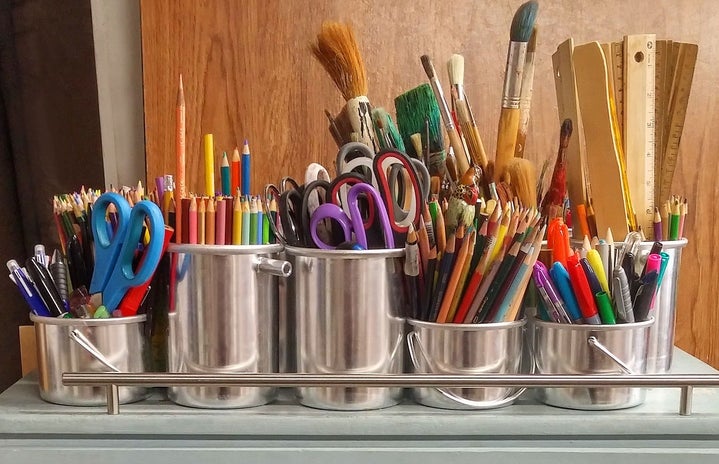Steam Visiting Art Series hosted a lecture that addresses how people today are using technology to replace real human relationship. This lecture shows how art and technology can work together to explore the human body relationship.
The event was held at North Campus in the omni-auditorium on March 29. Tiffany Trenda, a new media performance artist showcased her work. At the lecture, Trenda talks about human excessiveness with technology and lack of human interactions. The following day, Trenda did an art performance called “Proximity Cinema” that allowed people to interact with her.
“I would interact with people in different ways,” said Trenda. “Expressing myself by like sticking out my tongue.
Trenda created a performance called “Urban Devotion” that has an animated screen of her face on her head. Also, she wear a white suite while preforming the piece. At her live performance, Trenda express her emotions through a program screen that send out different emotions.
The goal of this piece is to show people how they are devoted to the screen as if it is a human to human reaction. It pose the question are people trying to use technology to improve their lives or trying to replace human relationship with technology.
In one of Trenda’s recent work, “Body Code” she performs in a latex suit with QR codes on them.
A QR code is a machine-readable code that is use for reading information through a camera or a smart phone.
While Trenda is wearing the latex suit, viewers can scan her body with their phones. Then, the scan will take the viewers to a website. Depending on what body part the viewers scan, they will read google searches that consist of keywords: man-made chemicals and the body part they scan.
For instance, if someone scan Trenda’s arm it will show man-made chemicals that effects the arm.
The purpose of this live performance is to show people that toxic man-made chemicals are harmful substances affecting the human body.
“The screen is actually a veil,” said Trenda. “It’s a veil separating us from actual life and reality.”
Trenda noticed that people was looking at the live performance through the screen on their phones. Not only while they was scanning the QR code but the way they viewed the performance as a whole. Trenda believes that people are no longer present in the moment. According to Trenda, research has shown that taking pictures today has hindered our ability to remember events that are capture on a camera. Today, pictures are not seen as something unique like they once was.
In 2013, Trenda created a performance called “Proximity Cinema.” The performance was inspired by Valie Export’s piece called “Tap and Touch Cinema.”
Export is an Austrian artist that work includes video installations and body performances. In one of Export’s piece, she had a box over her breast and people was allowed to touch her breast in public setting.
Furthermore, Trenda became interested in Export’s piece and wanted to translate it into a modern piece. Therefore, Trenda toke 38 cell phone screens to put them into a suit and put proximity sensors on them.
Proximity sensors is a sensor that is able to detect the presence of a nearby object without physical touch.
As people get closer to Trenda, the suit will display different text. On Trenda’s arm, face, and legs the screens would say words like “Go Ahead” and “It’s okay.” Additionally, when the audience touches the screen it reveals a photo of Trenda’s body.
“When I did this piece some people were like I do not want a hug,” said Trenda. “I actually make them touch me,” said Trenda as she laughed.
During Trenda performance for this piece, she tries to have an intimate experience with people in the audience.
Trenda spoke about a time when she was performing this piece and a lady came with a group of 10 people. Trenda went over to the lady and cuddled with her for a long time. Afterward, the lady told Trenda’s assistant that it felt like Trenda knew that her daughter passed away a month ago. The lady asked Trenda’s assistant how did she knew to pick her out of her group of friends.
“We have to be in front of the person,” said Trenda. “These are the moments that are missed.”
Although Trenda did not know the women, she believes that people can understand each other on a different level. However, this level can never be achievable through skype or anything else. The only way to experience this level is in person.
“It was wonderful,” said Ellen Cohen-Berman, a student at BC. “All you wanted to do is get a gigantic hug from her.”
Cohen-Berman is a student that is taking ceramic and pottery classes and got a chance to experience a live art performance for the first time.
For anyone looking to get more information on Tiffany Trenda live performance art they can check out the website at tiffanytrenda.com.

